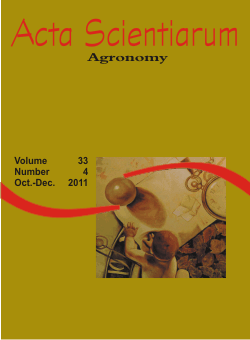<b>Non-destructive analysis of photosynthetic pigments in cotton plants</b> - doi: 10.4025/actasciagron.v33i4.10926
Resumo
Analytical techniques used to extract chlorophyll from plant leaves are destructive and based on the use of organic solvents. This study proposes a non-destructive quantification of the photosynthetic pigment concentration in cotton leaves using two portable chlorophyll meters, the SPAD-502 and the CLOROFILOG 1030. After obtaining 200 leaf discs, each with an area of 113 mm2, the greening rate in each disc was determined by the average of five readings from both meters. Immediately after measurement, 5 mL of dimethyl sulfoxide (DMSO) was added, and the samples were kept in a water bath at 70ºC for 30 min. After cooling, 3 mL of the liquid extract was used for analyses by spectrophotometry at 470, 646 and 663 nm. Mathematical models were adjusted from analytical results using the reading index obtained from both devices to predict the contents of chlorophyll a, chlorophyll b, total chlorophyll and carotenoids. Based on these results, it was concluded that both portable chlorophyll meters are an effective way to estimate the concentration of photosynthetic pigments in cotton leaves, thus saving time, space and the resources that are often required for these analyses.Downloads
DECLARAÇÃO DE ORIGINALIDADE E DIREITOS AUTORAIS
Declaro que o presente artigo é original, não tendo sido submetido à publicação em qualquer outro periódico nacional ou internacional, quer seja em parte ou em sua totalidade.
Os direitos autorais pertencem exclusivamente aos autores. Os direitos de licenciamento utilizados pelo periódico é a licença Creative Commons Attribution 4.0 (CC BY 4.0): são permitidos o compartilhamento (cópia e distribuição do material em qualqer meio ou formato) e adaptação (remix, transformação e criação de material a partir do conteúdo assim licenciado para quaisquer fins, inclusive comerciais.
Recomenda-se a leitura desse link para maiores informações sobre o tema: fornecimento de créditos e referências de forma correta, entre outros detalhes cruciais para uso adequado do material licenciado.




















































